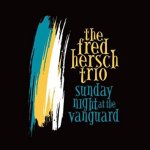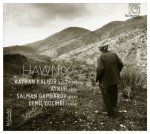PICK OF THE MONTH
 Ludwig Van Beethoven
Ludwig Van Beethoven
Missa Solemnis
Arnold Schoenberg Choir; Concentus Musicus Wien / Nicolaus Harnoncourt
Sony Classical
88985313592
 Ludwig Van Beethoven
Ludwig Van Beethoven
Symphonies 4 & 5
Concentus Musicus Wien / Nicolaus Harnoncourt
Sony Classical
88875136452
For the second month in a row, I feel compelled to offer two Picks of the Month instead of just one. This time the pairing is obvious: first, the final recording of Nicolaus Harnoncourt, who died earlier this year. Harnoncourt’s impact on the classical music world, and on that of period-instrument performance in particular, cannot be overestimated: his discography goes back 65 years (that’s 65), to the earliest beginnings of the period-instrument movement, and he has been one of that movement’s most influential and respected exponents ever since. It seems only too perfect that his final recording would consist of material taken from his final performances and rehearsals–and that the featured work would be Beethoven’s monumental Solemn Mass. Here it is imbued with all the weight and majesty one would expect, and if one gets a whiff of the valedictory in the way Harnoncourt takes his orchestra and soloists through the piece, well, that can’t really be coincidental. This is as fine a performance of the Missa Solemnis as you’re ever likely to hear.
The second recommended disc is, in some ways, just the opposite of the first: it represents (improbably enough) the first time that the Concentus Musicus Wien–which is, remember, the longest-standing period-instrument orchestra in existence–has recorded any of Beethoven’s symphonies (though Harnoncourt had recorded them with a different ensemble). To this recording of the fourth and fifth symphonies Harnoncourt brought a new appreciation for Beethoven’s sense of orchestration, one that had been honed by his recent direction of Beethoven’s opera Fidelio. Here the energy is simply explosive, and the fact that Harnoncourt was in his mid-80s at the time of recording is hard to believe. Both of these albums are must-owns for all classical library collections.
CLASSICAL
 Tõnu Kõrvits
Tõnu Kõrvits
Mirror
Various soloists; Tallinn Chamber Orchestra; Estonian Philharmonic Chamber Choir / Tõnu Kaljuste
ECM
2327
With this album, Tõnu Kõrvits joins the distinguished ranks of Estonian composers (Arvo Pärt being the most notable among them) who have worked with the German ECM label. The works presented here are a mix of instrumental and vocal, prominently featuring the Estonian Philharmonic Chamber Choir, in a variety of unusual orchestrations. For example, Seitsme linnu seitse und is scored for cello, choir, and string ensemble, whereas Tasase maa laul is for voice, strings, and kannel (a traditional Estonian instrument of the zither family). This is music of an often ethereal quality, and a sense of warm light glowing from within in a context of vast and chilly space–in short, this is the kind of music that many of us in the West have come to associate with modern Estonian composers. But it doesn’t sound exactly like anyone else’s, and all of it is very, very beautiful.
 Johann Sebastian Bach
Johann Sebastian Bach
Complete Concertos (9 discs)
Various orchestras, soloists, and conductors
Brilliant Classics (dist. Naxos)
95303
The Brilliant Classics label has put together yet another fine boxed set representing a large and significant chunk of works by a major composer. This time the composer is Bach and the chunk of works is his concertos: the Brandenburgs, the violin concertos, the (many) harpsichord concertos, and the miscellanea: concertos for oboe, the Triple Concerto, etc., as well as a separate disc of concerto reconstructions. As usual, the performances are by an assortment of (mostly Dutch) ensembles including Musica Amphion, the Amsterdam Bach Soloists, and the Netherlands Bach Ensemble, and the recordings from which this box is compiled were originally issued, for the most part, within the past 20 years or so. Both the price and the space savings represented by this box will be a boon to libraries that may not have already purchased Brilliant’s box set of the complete works of Bach.
 Christian Fennesz & Jim O’Rourke
Christian Fennesz & Jim O’Rourke
It’s Hard for Me to Say I’m Sorry
Editions Mego (dist. Forced Exposure)
EMEGO 221CD
 Claire M Singer
Claire M Singer
Solas (2 discs)
Touch (dist. Forced Exposure)
TO 101CD
Despite their obvious differences, I’m reviewing these two discs together because of what unites them: an aesthetic of droning, layering, and electronic manipulation. Christian Fennesz and Jim O’Rourke are both well-known names on the experimental/electronic music scene; both are guitarists, but both of them use electric and electronic manipulations extensively to make their instruments unrecognizable. The two tracks on this, their first collaboration as a duo, are simultaneously noisy and soft, shimmering and distorted, luscious and spiky. There is a deepness and density to the music here that rewards close and attentive listening. Claire M Singer is a composer who also works in drones and layers, but since she plays organ and cello (as well as using electronics), one might expect her work to be a bit less noisy and dense. And one would be right. The pieces presented on Solas span 14 years of her work, and find her playing and manipulating all of the instruments herself; the music is sometimes blissful and sometimes unsettling, and always both superficially simple and deeply interesting.
 Georg Muffat
Georg Muffat
Missa In labore requies
Cappella Murensis; Les Cornet Noirs
Audite (dist. Naxos)
97.539
Rick’s Pick
Georg Muffat is mainly known for his string compositions, but he also wrote a number of vocal works (both sacred and theatrical), almost all of which have been lost. This is particularly tragic in light of the quality of his one surviving Mass, the magisterial Missa in labore requies. Composed for two vocal choirs and three instrumental ensembles, plus continuo, this piece offers everything one might love about baroque sacred choral music: it’s sonically huge but carefully and richly detailed, serious but joyful, and brilliantly orchestrated. The performance is spectacular, aided in its effect by the wonderfully sympathetic acoustic of the Abbey Church of Muri. (The program includes sonatas by Bertali, Biber, and Schmelzer as makeweights.) Recommended to all classical collections.
 Franz Xaver Mozart; Muzio Clementi
Franz Xaver Mozart; Muzio Clementi
Piano Concertos
Howard Shelley; Sinfonieorchester St. Gallen
Hyperion (dist. Harmonia Mundi)
CDA68126
This is the third disc in pianist Howard Shelley’s ongoing survey of piano concertos of the classical period; the first two discs included works by Jan Ladislav Dussek and Daniel Steibelt, respectively, and each has been recommended in CD HotList. This one is every bit as rewarding as the first two, and offers the additional benefit of including two concertos by W. A. Mozart’s son Franz Xaver. F.X. Mozart is, predictably enough, something of a tragic figure in musical terms–a gifted composer and pianist doomed forever to be compared (inevitably unfavorably) to his freakishly gifted father. But his two works here really are delightful, and compare nicely to Clementi’s work–the only Clementi piano concerto not lost to history. As always, Shelley’s playing sparkles, and the Sinfonieorchester St. Gallen accompanies him wonderfully.
 Bernardino de Ribera
Bernardino de Ribera
Magnificat & Motets
De Profundis / David Skinner
Hyperion (dist. Harmonia Mundi)
CDA68141
Rick’s Pick
Although he served as a teacher to the young Tomás Luis de Victoria, Bernardino de Ribera left behind a relatively small number of compositions–and some of what we know he wrote (including two Mass settings) survive only in a choirbook that was so extensively vandalized that the music can no longer be reconstructed. The three Magnificat settings and ten motets performed here by the all-male De Profundis ensemble make clear how great a loss this vandalism incurred, not only for musicological scholarship but also for the listening pleasure of future generations. Ribera’s music is not only luscious, but also interesting in that it maps a transition from the influence of the Flemish school to the more specifically Spanish style of Guerrero and the distinctly Roman influences of Victoria. The singing is marvelous.
 Marin Marais
Marin Marais
Suites for Oboe
Christopher Palameta; Eric Tinkerhess; Romain Falik; Lisa Goode Crawford
Audax (dist. Albany)
ADX 13702
Say the name “Marais” to most baroque music aficionados, and they are most likely to think of his suites for the viola da gamba. But many of those works lend themselves to performance using other melody instruments, and while the oboe may not be the most obvious candidate for such transposition, oboist Christopher Palameta makes a strong case for that approach with this delightful album. Assisted by gamba player Eric Tinkerhess, lutenist Romain Falik, and harpsichordist Lisa Goode Crawford, Palameta plays what seem to be his own transcriptions of six suites from a variety of Marais’ collections, and he does so with grace, impeccable intonation, and an impressive richness of tone.
 Steve Reich
Steve Reich
Double Sextet; Radio Rewrite
Ensemble Signal / Brad Lubman
Harmonia Mundi
HMU 907671
From the very first chords of the first work, there is no question that you’re listening to the music of Steve Reich. Double Sextet features his trademark repetitive syncopated passages overlaid with sustained chords and punctuated by sudden changes in tempo and texture. Over the years Reich’s harmonic palette has gotten richer and more elaborate, but his interest in rhythm has not diminished. Radio Rewrite, the second work on this disc, is based on raw material from a song by the experimental rock band Radiohead, who similarly reworked a selection of Reich’s music for a tribute album some years back; here the composer returns the favor, to very nice effect. Ensemble Signal demonstrated their affinity for Reich’s work with an outstanding recording of his Music for 18 Musicians in 2015, and are just as good here. Highly recommended.
JAZZ
 Dave Douglas
Dave Douglas
Dark Territory
Greenleaf
GRE-CD-1049
They say that the three fundamental dimensions of music are melody, harmony, and rhythm, and that very few music cultures develop all three of them equally. (Compare, for example, Mozart’s harmonic complexity and rhythmic simplicity with the melodic complexity and harmonic simplicity of classical Indian music.) I kept thinking about that as I listened to trumpeter Dave Douglas’s new album, on which he leads a quartet through a set of performances that I found completely engrossing even though there’s hardly a melody worthy of the name anywhere on the album. The reason this music works so well has largely to do with rhythm (which is frequently compellingly funky) and with another dimenion of music that often gets overlooked: texture. One member of the group is credited only with playing “electronics,” and his contributions consist of noises and manipulations that create a huge and multifaceted sound stage against which Douglas, bassist Jonathan Maron, and drummer Mark Giuliana can bounce their individual and collective ideas. The result is alternately jazzy, funky, dubby, spacey, and skronky– and sometimes it’s all of those things at once.
 Manu Katché
Manu Katché
Unstatic
Anteprima Productions (dist. Naxos)
1
Drummer Manu Katché has been a first-call session drummer for decades now, first coming to wide public attention for his work with Peter Gabriel and Sting in the 1980s. But he’s also a gifted jazz composer and arranger, and has recorded several stylistically adventurous albums as a leader for the ECM label. On this apparently self-released album he leads a conventionally-configured quintet (piano trio with saxophone and trumpet) through a program of really quite straight-ahead original tunes: this isn’t bop or even post-bop, but it’s not fusion or experimental jazz either. It’s tunefully modern, and if the rhythms tend to drive and bounce more than they swing, that doesn’t detract from the essential jazziness of the mood. And the ballads are simply gorgeous. (One caveat: band introductions are just good manners in live setting. But on a studio recording? Silly and unnecessary.)
 Fred Hersch Trio
Fred Hersch Trio
Sunday Night at the Village Vanguard
Palmetto
PM2183
Rick’s Pick
To harp on Fred Hersch’s originality is kind of to miss what makes him such a great and influential player. What sets him apart from the pack is not so much that he does things others don’t do, but rather that he plays things in a way that is so much more expansive and insightful than what you hear from most other jazz pianists, even those who, with him, occupy the very top tier of pianistic achievement. On his latest trio outing you will hear echoes of Bill Evans in terms of the ensemble approach (the album title can’t have been an accident), but you’ll never hear Hersch himself actually play like Evans. You’ll hear a Monk tune that sounds nothing like Monk, and you’ll hear originals that sound like standards and standards that sound like originals. Throughout all of it you’ll hear Hersch taking musical ideas and stretching them, turning them upside down and inside out, and yet paradoxically never losing sight of their essential shape. There is, quite simply, no other pianist like him in the jazz world today.
 Mike Jones Trio
Mike Jones Trio
Roaring
Capri
74142-2
Rick’s Pick
For an almost diametrically opposed, but equally enjoyable, example of jazz pianism, consider the latest from the Mike Jones Trio. This album is resolutely, indeed maybe even defiantly, non-innovative. On it, pianist Jones and his trio prance their way through a ten-song set of standards–but not the ones we usually think of, the bop- and swing-era tunes that most of us can whistle on demand. These are standards from the 1920s, some of which are familiar still (“Yes Sir, That’s My Baby,” “Me and My Shadow,” etc.) and some of which are much less so. They are played here with puckish wit and freshness but also with a deep respect for the tradition from which they emerged. According to the liner notes, these recordings were mostly first takes, which suggests that this group needs to get together more often and record some more albums. Highly recommended to all jazz collections.
 Brazzamerica
Brazzamerica
Brazzamerica
Self-released
No cat. no.
Despite the album title, song names like “Lim Sim (Maracatu-Blues)” and “Samba da Lira,” and the fact that all three members of this piano trio are either from Brazil or deeply rooted in Brazilian music, the casual listener might not even notice that this is a Brazilian jazz album. Because really, it isn’t–it’s a jazz album made by Brazilians, and while the groove does often have that supple and liquid feel that we associate with samba and bossa nova, the rhythms themselves tend to be quite straight-ahead and the tunes rarely evoke Brazil melodically either. What you hear instead is a wonderful set of mainstream jazz numbers that, if you listen closely, evince a certain eu não sei o que. This is one of the most consistently enjoyable jazz albums I’ve heard all year.
FOLK/COUNTRY
 The Breath
The Breath
Carry Your Kin
Real World
CDRW213
Rick’s Pick
So imagine that Cocteau Twins consisted of an Irish singer and a jazz quartet. The result might have sounded something like this: lyrically unintelligible, lushly dense, stunningly beautiful. None of this music is from the folk tradition, and none of the music employs traditional Irish instruments, but the music somehow draws deeply on singer Ríoghnach Connolly’s Irishness even as it draws equally on jazz, ambient music, rock, and other folk sounds. It’s impossible to describe adequately–you really need to hear it.
 Jeff Scroggins and Colorado
Jeff Scroggins and Colorado
Ramblin Feels Good
Self-released
No cat. no.
It’s been interesting to watch the evolution of “progressive” bluegrass since the Country Gentlemen basically invented the genre in the 1960s. Back then it meant doing bluegrass versions of songs by Bob Dylan and Gordon Lightfoot and taking extra-long, jazzy solos. Over the years the progressive tendency has been expressed in a growing variety of ways by an increasing number of artists, and for banjoist Jeff Scroggins and his band it seems to mean blending whatever kinds of folk, country, and bluegrass music you enjoy and playing them however you prefer–though somehow their sound always ends up being solid and more or less mainstream whether the source material is Reno & Smiley, Willie Nelson, or (yes) Gordon Lightfoot. Singer Greg Blake is a solid vocalist and an outstanding guitarist, and Scroggins himself is a tasteful banjo player who knows just when to kick in with a fiery melodic passage. Very nice.
 Elias Alexander & Bywater Band
Elias Alexander & Bywater Band
Bywater
Fresh Haggis
No cat. no.
Elias Alexander is a piper and whistle player (and also a fiddler) who was raised in Oregon but fell in love with Celtic music in his early teens. His Bywater band plays original and traditional tunes deeply rooted in Celtic (and especially Scottish) tradition, with an edge of modern and youthful energy. Most of the tunes are instrumentals, but there are a few songs thrown in, and Elias is a good singer–but a better piper and whistle player, one with powerful tone and a wonderfully sure-footed sense of rhythm. The band as a whole sounds great, and illustrates once again how much fantastic Celtic music is being produced in the United States these days.
 Michael Fracasso
Michael Fracasso
Here Come the Savages
Blue Door
No cat. no.
I’ll be honest here: it took me a while to decide I was okay with Michael Fracasso’s voice, which is a quavery tenor that sometimes strikes me as a bit pretentious in its vulnerable instability. But I did eventually decide I was okay with it, and when I did, the songs started registering more powerfully. This disc is a sort of distillation of two albums he had originally intended to release separately, one of original songs and one of covers, and that was a good choice: up against the rock steady classic “You Don’t Love Me (No No No),” Fracasso’s own “Blind Man on a Bicycle” hits particularly hard, and his take on Johnny Thunders’ postpunk anthem “You Can’t Put Your Arms Around a Memory” turns it into a lush full band rumination, complete with steel guitar. The album culminates with a sunny and thoroughly lovely version of the Kinks’ “Better Things.” Fracasso sometimes gets pigeonholed as “psych-folk,” but I think he’s pretty much uncharacterizable.
ROCK/POP
 Fakear
Fakear
Animal
Counter
84
This is the debut full-length from an up-and-coming producer whose real name is Théo Le Vigoreux, and who has released a string of singles and EPs over the past few years. (The review download I received had only ten tracks, but apparently the CD has 16.) His sound is, to my ear, a nearly perfect blend of dreamy atmospherics, funky beats, attractive melodies, and charmingly startling change-ups, from the fragmented vocal samples on the title track and on the electro-acoustic dancehall yoga of “La Lune Rousse” to the slow-burn R&B of “Light Bullet” (featuring Audreya Triana). Highly recommended to all pop collections.
 Various Artists
Various Artists
Boombox 1: Early Independent Hip Hop, Electro and Disco Rap 1979-82 (2 discs)
Soul Jazz (dist. Redeye)
SJR CD334
Rick’s Pick
As is often the case with these Soul Jazz compilations, the subtitle reads like something off the cover of a scholarly monograph from a university press. And with good reason: once again, the label has given us a collection that not only functions well as a listening experience (these early rap singles may sound hokey today, but there’s no denying how much fun they are) but also as something of a musical/sociology/history text, granting the listener a window on the lyrical concerns and stylistic interconnections of various urban music styles at the turn of the 1980s. These were the earliest days of hip hop, a time when the boundaries between rap and disco were fuzzier than you might remember, when synthesizers were taking over, and when the scene was crawling with obscure rappers who made surprisingly fine singles. The accompanying booklet is rich with both textual and photographic information, and this set is a must-have for any library’s pop music collection.
 The Bangles
The Bangles
Ladies and Gentlement… the Bangles! (reissue)
Omnivore
OVCD-182
And speaking of the 1980s, here is a nicely expanded reissue of the eponymous debut EP by jangle-pop veterans the Bangles (known at the time as the Bangs), who exploded onto the music scene as part of the Paisley Underground movement before scoring mainstream success with “Walk Like an Egyptian,” a number-one hit single and constant presence on MTV. The EP shows both the band’s potential and the fact that they still had a ways to go before living up to it, but it’s tons of fun. So are the demo versions and live tracks that augment this reissue.
 Mikey Erg
Mikey Erg
Tentative Decisions
Don Giovanni (dist. Redeye)
DG-114
If scrappy, punky, resolutely lo-fi power pop is your cup of aggressively-compressed sonic sludge, then have I got the guy for you: Mikey Erg (formerly of The Ergs!, of New Brunswick, NJ), whose solo debut is chock full of deceptively sloppy-sounding hooks that are in fact carefully and meticulously crafted. The most artful pop architecture sounds like a mess when you thrash it out through a Fuzzbox and bounce it down to two tracks, but don’t be fooled: artful pop architecture is what Mikey Erg is selling, and it’s great. I’m looking forward to bringing this one home to my 17-year-old, and I anticipate that he’ll love it. I bet you will too. Hand-sell it to your patrons if they aren’t already intimately familiar with the New Brunswick, NJ punk-pop scene.
 Adriano Viterbini
Adriano Viterbini
FilmOSound
Bomba Dischi (dist. Redeye)
BMB04-2015
Adriano Viterbini may be the quintessential example of a guitar nerd–someone who has obsessively mastered a wide variety of guitar styles and techniques, whose range of interests spans far and wide both temporally and geographically, and who is willing to experiment pretty radically in pursuit of new tones. Hence his second solo album, on which he uses only an antique Bell & Howell Filmosound projector as a guitar amp and on which he explores spaghetti Western tunes, Hawaiian slack-key traditions, Delta blues, R&B, and Tiki lounge soundtrack music. Most of the tunes are instrumental and some are originals, but you’ll also hear familiar kitsch like “Sleepwalk” and a unexpectedly affecting take on “Five Hundred Miles.” All of it is imbued with Viterbini’s unique and winning blend of avant-garde experimentalism and unabashed nostalgia-mongering. Recommended.
WORLD/ETHNIC
 Ralph Samuelson
Ralph Samuelson
The Universal Flute
Innova
942
The shakuhachi is a Japanese end-blown bamboo flute that is notoriously difficult to play, but that has captivated the imaginations of several 20th- and 21st-century American composers. Here Ralph Samuelson, who likewise fell in love with the instrument back in the late 1960s, presents works for the shakuhachi by Henry Cowell, Richard Teitelbaum, and Elizabeth Brown, as well as pieces by Japanese composer Teizo Matsumura and Macanese composer Bun-Ching Lam. Some are solo works and some feature the koto, harp, or shamisen; the title piece (by Cowell) is presented both in a solo version and in a duet version with bansuri player Steve Gorn. This album is an outstanding example of the best of what can emerge from the cross-pollination of art music traditions between very different cultures.
 Hawniyaz
Hawniyaz
Hawniyaz
Harmonia Mundi
HMC 905277
Hawniyaz is a multicultural quartet consisting of Kurdish singer Aynur, Azerbaijani pianist Salman Gambarov, Iranian kamancheh player Kayhan Kalhor, and Kurdish/German tenbûr player Cemîl Qoçgirî. Together they make music that blends Kurdish and Persian vocal and instrumental traditions, with Gambarov’s piano adding an element of Western European classicism (and sometimes a gentle jazziness) to the mix. The resulting sound is intense but also refined and often strangely contemplative; Aynur’s voice is generally at the center of the mix, and it’s a thing of tough but light-filled loveliness. Recommended to all world-music collections.
 Various Artists
Various Artists
Why the Mountains Are Black: Primeval Greek Village Music 1907-1960 (2 discs)
Third Man Records
TMR 334
The liner notes of this album make condescending reference to listeners who “hear the pops and scratches” on these 78-rpm source recordings and find them “disconcerting.” To me, though, the rough sonic quality of the early shellac recordings is pretty much beside the point–what makes them tough to listen to is the music, much of which is brutally repetitious, harmonically static, and melodically dry. Why recommend this album to libraries, then? Because it contains a treasure trove of cultural information about traditional music cultures with which many in the West have had little or no interaction–and because some of it is musically thrilling. Strongly recommended to all libraries supporting ethnomusicology programs.